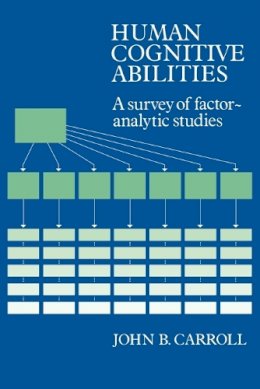
Stock image for illustration purposes only - book cover, edition or condition may vary.
Human Cognitive Abilities: A Survey of Factor-Analytic Studies
John B. Carroll
€ 62.30
FREE Delivery in Ireland
Description for Human Cognitive Abilities: A Survey of Factor-Analytic Studies
Paperback. This 1993 work surveys and summarizes the results of more than seventy years of investigation into human cognitive ability. Num Pages: 828 pages, 14 line drawings, 133 tables, references, indexes. BIC Classification: JMR. Category: (P) Professional & Vocational. Dimension: 235 x 158 x 47. Weight in Grams: 1208.
This 1993 work surveys and summarizes the results of more than seventy years of investigation, by factor analysis, of a variety of cognitive abilities, with particular attention to language, thinking, memory, visual and auditory perception, creativity and the production of ideas, and the speed and accuracy of mental processing. The author describes his detailed findings resulting from reanalysis of more than 460 data sets from the factor-analytic literature, followed by a presentation of a hierarchical, three-stratum theory of cognitive ability and its implications for further research. A set of three computer disks (IBM 3-1/2" 1.4 megabytes, ASCII format) containing the numerical data sets and Dr. Carroll's statistical results is also available. Representing over 4 megabytes of data or roughly 2000 printed pages the disks are major resources for the interested researcher.
Product Details
Format
Paperback
Publication date
1993
Publisher
Cambridge University Press United Kingdom
Number of pages
828
Condition
New
Number of Pages
828
Place of Publication
Cambridge, United Kingdom
ISBN
9780521387125
SKU
V9780521387125
Shipping Time
Usually ships in 4 to 8 working days
Ref
99-1
Reviews for Human Cognitive Abilities: A Survey of Factor-Analytic Studies
'John Carroll has done a magnificent hing: He has reviewed and reanalyzed the world's literature on individual differences in cognitive abilities, collected over most of a century, to reach an integrated picture. No one else could have done it. No one else would have applied so consistent and impartial a system on the literature, an dreached so balanced, complete, and useful a conclusion. It is a monumental contribution, destined to be brought and read in every university the world over that has a psychology or education department, and to be on many an individual scholar's shelf as well. It defines the taxonomy of cognitive differential psychology for many years to come.' Richard E. Snow, Stanford University
